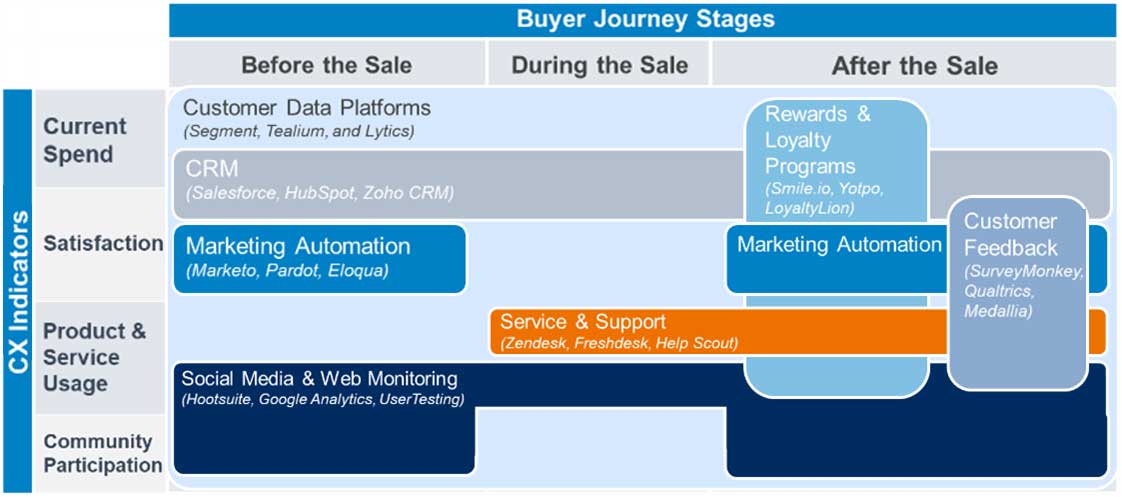Top Imperatives to Improve Customer Experience


Six Strategies to Improve Your CX
If you’re a tech company and not getting the revenue growth and margins you want, it might be due to poor customer experience (CX). CX is at the core of profitability, reflecting how well you retain and expand customers and acquire new logos. CX maturity – how well you engage customers and assign responsibilities – is a primary way to differentiate your organization from your competitors.
Customer experience is one of the keys to gaining long-term customers and driving business growth. CX can make the difference between a customer choosing your company or leaving for a competitor. A customer engagement ecosystem and defined sales plays and processes are two essential ways to enhance your CX maturity.
Tech Industry Pioneers CX Model
The technology industry pioneered the adoption of the subscription-based, recurring revenue model that later became the foundation for the CX ecosystem. Technology leaders were the first to develop consistent customer touchpoints, laying the groundwork for the new closed-loop sales model that includes:
- Identify – Marketing and Sales work together before the sale to increase awareness.
- Land – Sales and Marketing partner during the sale to land the customer.
- Adopt – Service and Sales team up to ensure user adoption after the sale.
- Expand – Marketing, Sales and Service contribute their CX knowledge to expand wallet share for future
- Renew – Marketing, Sales and Service develop coordinated plays to retain clients and secure recurring
This ecosystem (ILAER) requires all departments involved in the ongoing customer relationship to contribute to a core set of activities: find out what the customer needs, stay engaged to ensure the solution is meeting or exceeding customer expectations, and help the customer evolve as their needs and market change.
This model has since expanded across multiple industries. Alexander Group’s research shows companies that excel at developing, engaging and serving their customers with the ILAER model consistently experience:
- 12% greater EBITDA Margin
- 27% more effective customer retention
- 36% more effective account penetration
- 15% more effective new logo acquisition
*Based on Alexander Group Customer Experience Index
These industry leaders excel in CX sophistication and customer engagement. In this article, we will review the top six imperatives to improve CX – a core element in differentiating high-performing technology companies from their lower-performing peers.
How Improving the Customer Experience Increases Revenue
CX improvements offer many benefits that increase revenue for businesses, including:
- Enhanced brand image: The quality of customer interactions impacts your brand reputation. Dedicated customer service allows your company to stand out from the competition and improve your brand value.
- Improved reputation and reviews: Positive customer reviews by word of mouth or online platforms can improve your company’s reputation and expand your customer base, leading to higher revenue.
- Reduced churn: CX is the foundation of customer retention, as prioritizing customer service reduces churn. Customers will remain loyal and return to companies that provide excellent customer service.
Challenges in Enhancing the Customer Experience
Despite the value and importance of a good customer experience, it can be challenging for companies to deliver on this initiative.
Businesses can experience many obstacles in improving CX, including:
- Lack of customer feedback: Customer feedback helps companies understand how satisfied their customers are with the products, services and other offerings. A lack of feedback is a lost opportunity to respond to your customers’ needs and make decisions that will improve customer retention.
- Poor or outdated technology: Insufficient technology can make tasks like analyzing data and responding to customers difficult or impossible. Manual labor may be needed to fill in the gaps, which can lead to errors and long response times.
- Data silos across the organization: A lack of communication and shared resources across a company can give your team an incomplete picture of the customer experience, making it difficult to improve CX.
Top 6 Imperatives to Improve CX
Leadership & Alignment
1. Hire a CX Leader and reorient the C-suite org structure
2. Ensure CX is embedded across all customer-facing functions (both virtual and in-person)
Data & Enablement
3. Build/optimize a measurement system for tracking CX across multiple variables
4. Align internal pay and/or performance management systems to have a focus on CX
Feedback Loop
5. Have a well-coordinated and codified feedback mechanism from customers, partners and throughout the organization to understand the root causes that compromise CX
6. Understand the importance of happy employees and the employee experience (EX). Gather feedback and insights on employee satisfaction directly translates to higher customer satisfaction levels
Leadership & Alignment
Effective CX requires a level of buy-in across the entire organization – starting with the C-suite. Ensuring your organization has a CX leader with either a seat at the C-suite table or direct access to C-suite leadership is a must. This will ensure that there is alignment at the leadership level to develop and execute a CX vision and strategy.
CX does not just sit with one organization or team. Customer-facing roles have the most influence over CX, but require clear rules of engagement to be effective. Organizations should drive CX culture and principles into action by orienting jobs towards customer engagement and setting clear engagement expectations; the benefits of CX need to be clear to everyone at the ground level.
The goal is to identify and utilize customer pain points to improve CX tangibly over time. Technology leaders stay apprised of customer problems, solutions and evolving expectations while also securing engagement and boosting revenue. They know that proper execution requires sales, marketing, service and related departments to stay abreast of customer needs and then relay this information to the right contact points.
Data & Enablement
Leveraging data across the entire customer experience is critical to develop insights and trends around customer experience. To ensure that data and insights are consistent across the entire customer journey, CX leaders need to align on a range of KPIs to measure customer engagement. Technology CX leaders say that customer and revenue retention are the most useful metrics to measure customer engagement. CX leaders are combining metrics that are more easily quantifiable with traditional self-reported satisfaction metrics to build predictive indicators that correlate with business outcomes.
Organizations must distinctly define plays and leverage tools to drive engagement and growth. CX excellence requires that tech leaders leverage customer insights to identify buyer-specific use cases for solution selling and link these use cases to engagement plays and sales objectives.
CX does not solely reside with one function or role. Leading CX companies are including measures and KPIs into both pay and performance management systems to reinforce the focus on CX across traditionally siloed organizations. Connecting metrics to customer-facing roles requires understanding which sales motions the role is responsible for and how these roles can influence customer outcomes.
Feedback Loop
![]() Collecting insights and feedback from customers is imperative to quickly combating any issues or pain points.
Collecting insights and feedback from customers is imperative to quickly combating any issues or pain points.
To effectively understand customer behavior, leading CX companies enable insightful CX tracking with the right tech tools that align with CX indicators and the buyer journey. Leading technology companies use data insights to reveal potential problems and solutions, enhancing CX by offering proactive solutions or increasing awareness. CX leaders use various tools to collect different types of customer insights that can reflect spend, satisfaction, product/service usage and community participation at every point in the ILAER ecosystem.

To drive successful CX programs, an engaged workforce is a key factor. Strong employee engagement programs result in an exceptional employee experience (EX) which improves CX outcomes. Retaining diverse and best-in-class talent requires formal and effective programs in place for elements of the employee experience such as flexible working hours, hybrid work environment and more favorable leave of absence policies. Simply stated, happy employees make for happy customers, making CX easier and more profitable. Companies with strong EX report high satisfaction levels with sales reps and experience higher service quality.
Conclusion
CX is top of mind for leading organizations. It is a well-coordinated effort that requires executive buy-in, an overarching strategy as well as tactical elements such as sales plays. To continuously improve, collecting and acting upon data and insights is critical.

Need Help?
CX leaders report tracking CX via CRM, feedback and survey tools, and web analytics among other tools. If you are interested in hearing more about strategies to augment your company’s customer experience, contact us.



